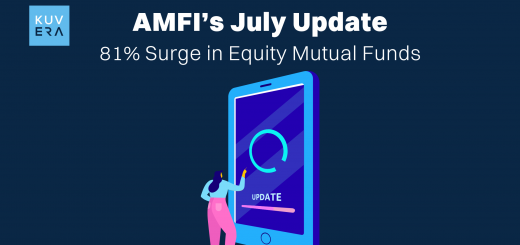While borrowing through any kind of a loan, what is the most important thing that the lenders look for?
The answer is: “your credit score or CIBIL score”!
The same fundamental question is also applicable to borrowing companies.
Yes, credit ratings are nothing but credit scores for borrowing companies.
Among the popular avenues for wealth creation and preservation, why do debt mutual funds stand out?
Because they offer investors a way to participate in the fixed-income market. These funds pool money from numerous investors to invest in a variety of debt instruments, such as corporate bonds, government securities, treasury bills, commercial papers, and other money market instruments.
Why Choose Debt Funds?
Debt funds can appear as a more stable alternative when compared to the volatility of equity markets. However, characterising debt mutual funds as entirely risk-free can be a simplification that overlooks crucial aspects of their functioning and the factors that influence their performance.
A fundamental element that can significantly impact the risk profile and potential returns of debt mutual funds is the credit quality of the underlying securities. This credit quality is primarily assessed and communicated through credit ratings assigned by specialised agencies.
Understanding credit ratings is not merely an academic exercise for investors. It stands as a critical discipline for making informed decisions about where to allocate capital within the debt fund universe.
Credit ratings can serve as an independent evaluation of the creditworthiness of an issuer or a specific debt instrument. Essentially, a credit rating represents an opinion on the likelihood of the issuer meeting its debt obligations, including timely payment of interest and repayment of the principal amount upon maturity.
These ratings can provide a standardised measure of credit risk, allowing investors to compare the relative safety of different debt instruments. For individuals considering investments in debt mutual funds, comprehending the significance of these ratings becomes paramount.
The credit quality of the bonds and other debt instruments held within a debt fund’s portfolio directly influences the fund’s overall risk level and its susceptibility to potential losses arising from defaults.
What are Credit Rating Agencies?
Credit rating agencies are independent entities that specialise in assessing and rating the creditworthiness of various borrowers, including corporations, financial institutions, and even governments.
They generally employ a team of analysts who conduct thorough research and analysis of an issuer’s financial health, business model, industry dynamics, management quality, and macroeconomic factors. Based on this comprehensive evaluation, they assign a credit rating to the issuer or its specific debt instruments.
Credit Rating Agencies in India
In India, prominent credit rating agencies include CRISIL, ICRA, CARE Ratings, and India Ratings and Research, among others. These agencies can play a vital role in the financial ecosystem by providing valuable information that enhances market transparency and assists investors in evaluating credit risk.
Credit Rating Scale in India
The credit rating scale can typically range from the highest quality, indicating the lowest credit risk, to the lowest quality, signifying a very high probability of default. While the specific symbols used may vary slightly across different rating agencies, a widely recognised scale for long-term debt instruments utilises letter designations such as ‘AAA’, ‘AA’, ‘A’, ‘BBB’, ‘BB’, ‘B’, ‘CCC’, ‘CC’, ‘C’, and ‘D’.
1. AAA (Triple A)
This rating signifies the highest credit quality and indicates an exceptionally strong capacity for timely repayment of debt obligations. Instruments rated ‘AAA’ carry the lowest expectation of default risk.
2. AA (Double A)
Instruments with an ‘AA’ rating demonstrate very high credit quality and a very low default risk. They are considered very safe investments.
3. A (Single A)
An ‘A’ rating represents high credit quality with a low default risk. These instruments are still considered secure, though slightly more susceptible to adverse economic conditions than ‘AA’ or ‘AAA’ rated instruments.
4. BBB (Triple B)
Instruments rated ‘BBB’ exhibit medium credit quality and a moderate default risk. This is generally considered the lowest tier of “investment grade” ratings. Debt instruments rated ‘BBB’ or higher are typically regarded as suitable for conservative investors.
5. BB (Double B)
A ‘BB’ rating falls into the “speculative grade” or “junk bond” category. Instruments with this rating have a moderate default risk and are considered more speculative.
6. B (Single B)
Instruments rated ‘B’ demonstrate highly speculative credit quality with an increased default risk.
7. CCC (Triple C)
A ‘CCC’ rating indicates very low credit quality and a high default risk. An investment in such instruments carries significant risk of loss.
8. CC (Double C)
Instruments rated ‘CC’ exhibit very low credit quality, and an event of default appears very likely.
9. C (Single C)
This rating signifies the lowest credit quality, and an event of default is considered imminent.
10. D (Default)
An instrument with a ‘D’ rating is already in default, meaning the issuer has failed to meet its debt obligations.
Many rating agencies also use plus (+) and minus (-) modifiers within the rating categories from ‘AA’ to ‘C’ to provide a more granular assessment of credit quality within that specific band.
For short-term debt instruments, a different rating scale is typically used, often involving symbols like ‘A1’, ‘A2’, ‘A3’, ‘A4’, and ‘D’, representing varying degrees of safety and credit risk over a shorter time horizon.
The credit rating of a debt instrument can directly influence its yield or the interest rate it offers. Generally, instruments with higher credit ratings, signifying lower credit risk, offer lower yields. This can occur because investors are willing to accept a lower return for the higher certainty of receiving their principal and interest payments.
Conversely, instruments with lower credit ratings, which carry higher credit risk, must offer higher yields to compensate investors for taking on that increased risk. This fundamental relationship between credit risk and yield is a cornerstone of fixed-income investing.
Credit Ratings and Debt Mutual Funds
For debt mutual funds, the average credit quality of the underlying portfolio has a significant impact on the fund’s potential returns and its risk profile. Funds that primarily invest in high-rated instruments (e.g., ‘AAA’, ‘AA’) might be considered to have lower credit risk and offer more stability. These funds can often be suitable for investors with a conservative risk appetite who prioritise the preservation of capital.
On the other hand, debt mutual funds that allocate a substantial portion of their portfolio to lower-rated or speculative-grade instruments (e.g., ‘BB’, ‘B’, ‘CCC’) are typically classified as “credit risk funds” or “high-yield funds.” These funds carry a higher credit risk but offer the potential for higher returns due to the higher yields offered by these riskier bonds. Investors considering such funds should have a higher risk appetite and a clear understanding of the increased possibility of defaults.
The fund manager of a debt mutual funds scheme can play a crucial role in managing the credit risk of the portfolio. They conduct their own independent credit analysis in addition to relying on the ratings provided by external agencies. Fund managers can decide which debt instruments to buy or sell based on their assessment of the issuer’s creditworthiness, market conditions, and the fund’s investment objective.
In credit risk funds, the fund manager’s expertise in identifying potentially undervalued or improving credit stories becomes particularly important. They might invest in lower-rated bonds that they believe have a strong chance of a credit rating upgrade, which could lead to an appreciation in the bond’s price and consequently the fund’s Net Asset Value (NAV).
What Happens When Credit Ratings of Debt Funds Change?
Changes in the credit rating of a debt instrument held by a debt mutual fund can directly impact the fund’s NAV. A downgrade in the credit rating of a bond suggests that the issuer’s creditworthiness has deteriorated, increasing the perceived risk of default. This increased risk typically leads to a decrease in the market price of that bond. As the value of the underlying asset falls, the NAV of the debt fund holding that bond also tends to decline.
Conversely, an upgrade in a bond’s credit rating indicates an improvement in the issuer’s financial health and a lower probability of default. This positive development usually results in an increase in the bond’s market price, leading to an appreciation in the debt fund’s NAV. Therefore, continuous monitoring of the credit quality of portfolio holdings and staying informed about potential rating changes are essential aspects of managing debt fund investments.
Investors evaluating debt mutual funds need to look beyond just the historical returns. While past performance provides some indication, it is not a guarantee of future results. A thorough understanding of the fund’s investment strategy, its portfolio holdings, and the average credit quality of those holdings provides a more insightful picture of the fund’s risk profile.
Fund fact sheets and Scheme Information Documents (SID) typically provide details about the fund’s asset allocation and the credit profile of the portfolio. Investors can examine the proportion of the portfolio invested in different credit rating categories. A fund with a large allocation to lower-rated instruments carries higher credit risk compared to a fund predominantly invested in high-rated securities.
Regulatory bodies like the Securities and Exchange Board of India (SEBI) have also implemented guidelines concerning credit ratings for mutual funds. These regulations aim to enhance transparency and protect investors. For instance, SEBI mandates that debt funds disclose the credit quality of their portfolios.
Furthermore, there are limits on the maximum exposure a debt fund can have to instruments issued by a single entity, with these limits often linked to the credit rating of the issuer. These regulations encourage diversification and help mitigate concentration risk within debt fund portfolios.
Selecting Debt Mutual Funds
When selecting debt mutual funds, aligning your investment choice with your individual risk appetite and investment horizon is crucial. If you are a conservative investor who prioritises capital preservation and seeks stable returns, opting for debt funds that invest primarily in high-rated, investment-grade instruments (rated ‘BBB’ and above) might be better. These funds typically exhibit lower volatility and a reduced risk of credit defaults.
However, for investors with a higher risk appetite who are willing to accept greater potential volatility for the possibility of higher returns, credit risk funds or funds investing in a mix of investment-grade and speculative-grade instruments might be considered.
It is imperative to conduct thorough due diligence and understand the specific risks associated with these funds.
Evaluating the credit quality of a debt mutual fund portfolio can also involve understanding the concept of “average credit quality.” This metric provides a single snapshot of the overall creditworthiness of the securities held by the fund, often calculated as a weighted average of the credit ratings of individual holdings.
A higher average credit quality score indicates a portfolio composed of more creditworthy instruments, suggesting lower overall credit risk. Conversely, a lower average credit quality score points towards a portfolio with a greater proportion of lower-rated, higher-risk securities.
Investors need not solely rely on credit ratings as the only factor when making investment decisions regarding debt mutual funds. Credit ratings provide a valuable assessment of credit risk, but they are not foolproof. Rating agencies provide opinions based on available information at a particular point in time, and these ratings can change. Economic conditions, industry-specific factors, and the financial performance of the issuer can all influence future creditworthiness. Therefore, investors should use credit ratings as an important tool within a broader due diligence process. This process should include reviewing the fund’s investment objective, strategy, expense ratio, fund manager’s track record, and the fund’s historical performance across different market cycles.
Wrapping Up
Navigating the world of debt mutual funds can require a clear understanding of the inherent risks. Credit risk in debt mutual funds seems to stand as a primary concern. Credit ratings can act as indispensable guides. They can offer investors a standardised assessment of the creditworthiness of the underlying debt instruments. With the help of transparent and accurate credit ratings, investors can make more informed decisions aligned with their financial goals and risk appetite. As a diligent investor, you can take the time to examine the credit quality of a debt fund’s portfolio. You can recognize that while higher credit quality may mean potentially lower yields. It can also translate to a higher degree of safety and stability in their investment. Ultimately, a comprehensive approach that incorporates an analysis of credit ratings alongside other relevant factors provides a stronger foundation for successful investing in debt mutual funds.
Interested in how we think about the markets?
Read more: Zen And The Art Of Investing
Watch here: Learn about the F&O craze in India












